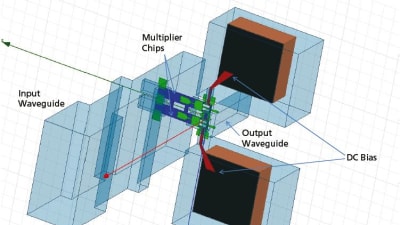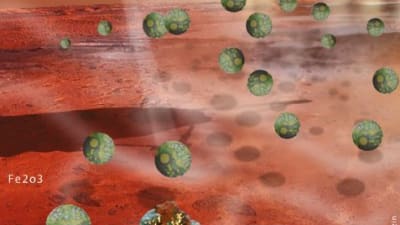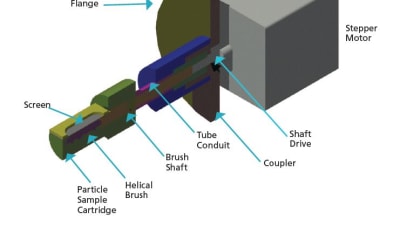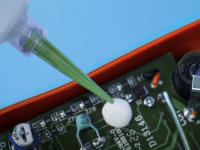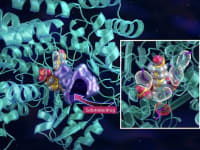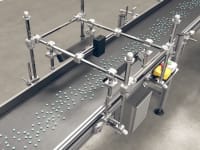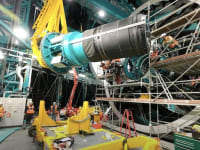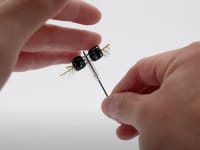61
169
-1
5400
30
Briefs: Software
A software package reads and analyzes pressure distributions from sensors mounted under a person’s feet. Pressure data from sensors mounted in shoes, or in a platform, can be...
Briefs: Physical Sciences
Surface-Enhanced Raman Scattering Using Silica Whispering- Gallery Mode Resonators
The motivation of this work was to have robust spectroscopic sensors for sensitive detection and chemical analysis of organic and molecular compounds. The solution is to use silica sphere optical resonators to provide surface-enhanced spectroscopic signal.
Briefs: Information Technology
3D Hail Size Distribution Interpolation/Extrapolation Algorithm
Radar data can usually detect hail; however, it is difficult for present day radar to accurately discriminate between hail and rain. Local ground-based hail sensors are much better at detecting hail against a rain background, and when incorporated with radar data, provide a much better...
Briefs: Physical Sciences
Color-Changing Sensors for Detecting the Presence of Hypergolic Fuels
Hypergolic fuel sensors were designed to incorporate novel chemo chromic pigments into substrates for use in various methods of leak detection. There are several embodiments to this invention that would provide specific visual indication of hypergols used during and after...
Briefs: Materials
Using Pre-Melted Phase Change Material to Keep Payloads in Space Warm for Hours Without Power
Adding phase change material (PCM) to a mission payload can maintain its temperature above the cold survival limit, without power, for several hours in space. For the International Space Station, PCM is melted by heaters just prior to the payload...
Briefs: Materials
Fibrillar Adhesive for Climbing Robots
A climbing robot needs to use its adhesive patches over and over again as it scales a slope. Replacing the adhesive at each step is generally impractical. If the adhesive or attachment mechanism cannot be used repeatedly, then the robot must carry an extra load of this adhesive to apply a fresh layer with each...
Briefs: Materials
Transformers: Shape-Changing Space Systems Built With Robotic Textiles
Prior approaches to transformer-like robots had only very limited success. They suffer from lack of reliability, ability to integrate large surfaces, and very modest change in overall shape. Robots can now be built from two-dimensional (2D) layers of robotic fabric. This expands...
Briefs: Manufacturing & Prototyping
The harmful properties of lunar dust, such as small size, glass composition, abnormal surface area, and coatings of imbedded nanophase iron, lead to a unique coupling of the...
Briefs: Manufacturing & Prototyping
Development of a Centrifugal Technique for the Microbial Bioburden Analysis of Freon (CFC-11)
NASA Procedural Requirement 8020.12C entitled “Planetary Protection Provisions for Robotic Extraterrestrial Missions” states that the source-specific encapsulated microbial density for encapsulated organisms (div(0)) in nonmetallic materials ranges...
Briefs: Electronics & Computers
DSP/FPGA Design for a High-Speed Programmable S-Band Space Transceiver
Traditional command uplink receivers are very limited in performance capability, take a long time to acquire, cannot operate on both uplink bands (NASA & AFSCN), and only support low-rate communications. As a result, transceivers end up on many programs’ critical paths, even...
Briefs: Electronics & Computers
Memory Circuit Fault Simulator
Spacecraft are known to experience significant memory part-related failures and problems, both pre- and post-launch. These memory parts include both static and dynamic memories (SRAM and DRAM). These failures manifest themselves in a variety of ways, such as pattern-sensitive failures, timing- sensitive failures, etc....
Briefs: Electronics & Computers
A 1.6-THz power-combined Schottky frequency tripler was designed to handle approximately 30 mW input power. The design of Schottky-based triplers at this...
Briefs: Electronics & Computers
FPGA Vision Data Architecture
JPL has produced a series of FPGA (field programmable gate array) vision algorithms that were written with custom interfaces to get data in and out of each vision module. Each module has unique requirements on the data interface, and further vision modules are continually being developed, each with their own custom...
Briefs: Mechanical & Fluid Systems
Ultra-Compact Transputer-Based Controller for High-Level, Multi-Axis Coordination
The design of machines that rely on arrays of servomotors such as robotic arms, orbital platforms, and combinations of both, imposes a heavy computational burden to coordinate their actions to perform coherent tasks. For example, the robotic equivalent of a person...
Briefs: Mechanical & Fluid Systems
Magnetically Actuated Seal
This invention is a magnetically actuated seal in which either a single electromagnet, or multiple electromagnets, are used to control the seal’s position. This system can either be an open/close type of system or an actively controlled system.
Briefs: Mechanical & Fluid Systems
Regolith Advanced Surface Systems Operations Robot Excavator
The Regolith Advanced Surface Systems Operations Robot (RASSOR) excavator robot is a teleoperated mobility platform with a space regolith excavation capability. This more compact, lightweight design (
Briefs: Mechanical & Fluid Systems
Hybrid Electrostatic/ Flextensional Mir ror for Lightweight, Large-Aperture, and Cr yogenic Space Telescopes
A lightweight, cryogenically capable, scalable, deformable mirror has been developed for space telescopes. This innovation makes use of polymer-based membrane mirror technology to enable large-aperture mirrors that can be easily launched and...
Briefs: Physical Sciences
A revolutionary way is proposed of studying the surface of Mars using a wind-driven network of mobile sensors: GOWON. GOWON would be a scalable, self-powered and...
Briefs: Physical Sciences
Analysis of the Effects of Streamwise Lift Distribution on Sonic Boom Signature
Investigation of sonic boom has been one of the major areas of study in aeronautics due to the benefits a low-boom aircraft has in both civilian and military applications. Current Federal Aviation Administration regulations prohibit supersonic flight over land due to...
Briefs: Physical Sciences
Particle seeding is a key diagnostic component of filter testing and flow imaging techniques. Typical particle generators rely on pressurized air or gas sources to propel the particles into the flow field. Other...
Briefs: Information Technology
System for Contributing and Discovering Derived Mission and Science Data
A system was developed to provide a new mechanism for members of the mission community to create and contribute new science data to the rest of the community. Mission tools have allowed members of the mission community to share first order data (data that is created by the...
Briefs: Software
Remote Viewer for Maritime Robotics Software
This software is a viewer program for maritime robotics software that provides a 3D visualization of the boat pose, its position history, ENC (Electrical Nautical Chart) information, camera images, map overlay, and detected tracks.
Briefs: Software
Stackfile Database
This software provides storage retrieval and analysis functionality for managing satellite altimetry data. It improves the efficiency and analysis capabilities of existing database software with improved flexibility and documentation. It offers flexibility in the type of data that can be stored. There is efficient retrieval...
Briefs: Software
Reachability Maps for In Situ Operations
This work covers two programs that accomplish the same goal: creation of a “reachability map” from stereo imagery that tells where operators of a robotic arm can reach or touch the surface, and with which instruments. The programs are “marsreach” (for MER) and “phxreach.” These programs make use...
Briefs: Software
JPL Space Telecommunications Radio System Operating Environment
A flight-qualified implementation of a Software Defined Radio (SDR) Operating Environment for the JPL-SDR built for the CoNNeCT Project has been developed. It is compliant with the NASA Space Telecommunications Radio System (STRS) Architecture Standard, and provides the software...
Briefs: Software
RFI-SIM: RFI Simulation Package
RFI-SIM simulates the RFI environment to estimate the interference from terrestrial emitters into spacecraft, or vice versa. A high-fidelity simulation of the RFI environment has been developed by employing all antenna-related and radar systemrelated parameters of multiple emitters, as well as that of the desired...
Briefs: Software
ION Configuration Editor
The configuration of ION (Interplanetary Overlay Network) network nodes is a manual task that is complex, time-consuming, and error-prone. This program seeks to accelerate this job and produce reliable configurations.
Briefs: Software
Dtest Testing Software
This software runs a suite of arbitrary software tests spanning various software languages and types of tests (unit level, system level, or file comparison tests). The dtest utility can be set to automate periodic testing of large suites of software, as well as running individual tests. It supports distributing multiple tests...
Briefs: Information Technology
IMPaCT — Integration of Missions, Programs, and Core Technologies
IMPaCT enables comprehensive information on current NASA missions, prospective future missions, and the technologies that NASA is investing in, or considering investing in, to be accessed from a common Web-based interface. It allows dependencies to be established between missions...
Top Stories
Blog: Manufacturing & Prototyping
2025 Holiday Gift Guide for Engineers: Tech, Tools, and Gadgets
INSIDER: Research Lab
Scientists Create Superconducting Semiconductor Material
Blog: Software
Quiz: Materials
Blog: Aerospace
Tech Briefs Wrapped 2025: Top 10 Technology Stories
Blog: Manufacturing & Prototyping
Webcasts
 Upcoming Webinars: AR/AI
Upcoming Webinars: AR/AI
The Real Impact of AR and AI in the Industrial Equipment Industry
 Upcoming Webinars: Motion Control
Upcoming Webinars: Motion Control
Next-Generation Linear and Rotary Stages: When Ultra Precision...
 Upcoming Webinars: Energy
Upcoming Webinars: Energy
Hydrogen Engines Are Heating Up for Heavy Duty
 Podcasts: Medical
Podcasts: Medical
How Wearables Are Enhancing Smart Drug Delivery
 Podcasts: Power
Podcasts: Power
SAE Automotive Podcast: Solid-State Batteries




